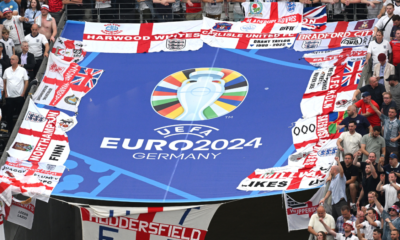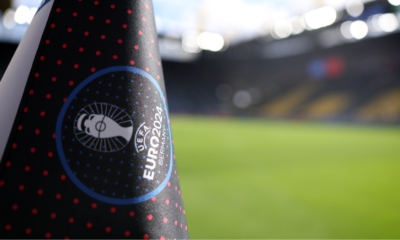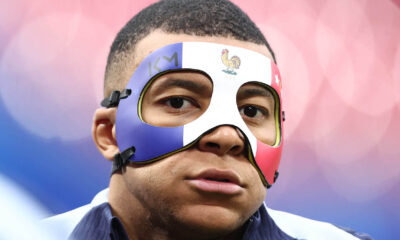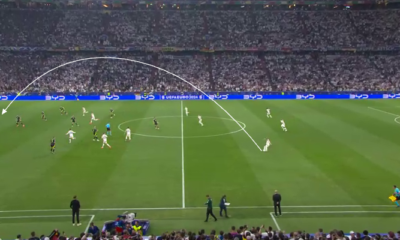Sports
Adolf Hitler, Jesse Owens and Berlin’s Olympiastadion: the complicated history of Euro 2024 final venue
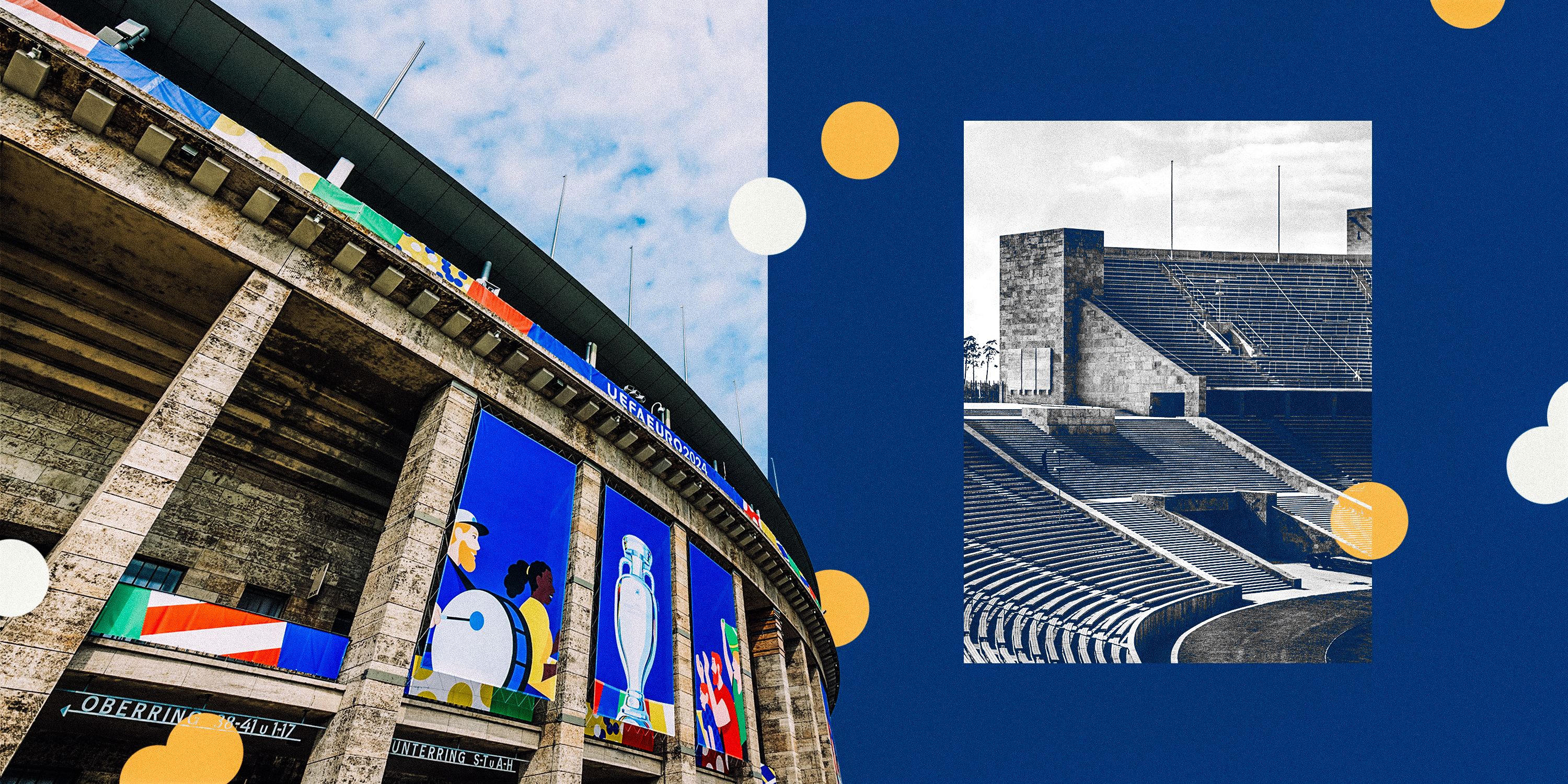
Follow live coverage of Hungary vs Switzerland at Euro 2024 today
The showpiece final of this summer’s European Championship, likely to attract a worldwide television audience in excess of 300 million people, will be played on July 14 at the Olympiastadion in Berlin — a stadium originally built and funded on the orders of Europe’s most notorious dictator, Adolf Hitler.
Eighty-eight years have passed since the 1936 summer Olympic Games were also staged there, three years after Hitler, the leader of the Nazi Party, became the country’s chancellor and ruler.
These days, it’s a 74,000-seat stadium with a sleek, modern roof, but the setting stands as a testament to a blood-soaked history.
Over the next month, three group games, starting with Spain against Croatia on Saturday, will be played there, as well as a round of 16 match, a quarter-final and then the final itself. The hundreds of thousands of football supporters who descend on the Olympiastadion will be confronted by many of the features that distinguished this venue as a Nazi shrine almost a century ago.
Since 1945, Germany has grappled with its history in a thoughtful way.
Being Germany, there is a word for it: vergangenheitsaufarbeitung, which translates to mean ‘working from the past.’
Hitler’s bunker in Berlin was filled in with concrete to avoid it becoming a commemoration site, and the Spandau prison, where his deputy Rudolf Hess committed suicide, was destroyed. German children are taught in schools about Nazi atrocities and those training to become police officers are taught the history of the Holocaust and taken to the sites of former concentration camps to understand the gravity. The vast Holocaust memorial is located at the heart of a reunified Berlin.
The Olympiastadion, however, is a listed building, preserved since 1966, albeit its history is vividly detailed by tour guides and via a small museum.
Considered solely as an architectural feat, the stadium is intimidating and magisterial. Situated on the western outskirts of Germany’s capital, at the tip of the Grunewald forest, the five rings of the Olympic emblem remain strung between arresting twin stone towers. These are two of six towers once plotted around the stadium, each representing what the Nazis considered to be “great German tribes” who would unite under National Socialism; these were the Bavarians, Franconians, Swabians, Frisians, Saxons and Prussians, and a plaque outside the arena says they were supposed to embody “the virtues of a glorious past, which had been lost in the modern age” and preserve the “blutserbe” (blood heritage) of a Nordic master race.
With its oval shape, austere colonnades and soaring terraces, the stadium was designed as a stark statement of German might at a time of rising global tensions in the 1930s. Partially below ground level, it was intentionally constructed to evoke comparisons with the Colosseum in Rome.
To wander around the stadium, as The Athletic did earlier this year, is to witness many of the hallmarks familiar to Olympia, the infamous Leni Riefenstahl propaganda film ordered by the Nazi high command, about those 1936 Olympics.

Construction of the stadium before the 1936 Olympics (Bettmann/Getty Images)
On a cold, wintery, grey day, the eeriness is all-consuming; swathes of vast space and haunting relics. The colonnades remain intact, so too the Olympic cauldron, located just inside the Marathon Gate, with that cold, ageless, durable design that is in keeping with the architecture of the Third Reich.
The Nazi swastikas have long since been torn down, but nothing quite prepares you for the chilling moment an Olympiastadion tour guide points to a balcony and explains that you are metres away from where Hitler once took pride of place, receiving ‘Heil’ salutes from crowds and athletes alike.
Dotted around the stadium are bronze statues, venerating the perceived power and splendour of the Aryan race. Its own website explains that construction companies were ordered to hire only “complying, non-union workers of German citizenship and Aryan race” to build this edifice of Nazism, meaning Jews in particular were not to be involved.
The Olympiastadion, therefore, will always be a museum in itself but over time, events have shaped a profound and complicated history.
At those 1936 Games, for example, Jesse Owens, an African-American athlete, won four gold medals in front of Hitler, producing arguably the most iconic Olympic performance of all time. In the aftermath of the Second World War, when Germany was divided into West and East, much of the wider Olympic Park was occupied by British forces between 1945 and 1994, using the grounds at times for polo events, and sometimes for parades to honour the birthday of Queen Elizabeth II.
This summer’s European Championship will not be its first major international football tournament, having hosted five matches during the 1974 World Cup, and six, including the final, of the 2006 World Cup, a match which is most famous for French superstar Zinedine Zidane headbutting Italian opponent Marco Materazzi.

Zidane headbutted Materazzi in the 2006 World Cup final (John MacDougall/AFP via Getty Images)
In 2015, it hosted the Champions League final, where Lionel Messi’s Barcelona defeated Juventus, while the stadium has also been the home venue of current 2. Bundesliga (the German second division) side Hertha Berlin since 1965 and staged the German Cup final every year since 1985.
American football’s NFL also played a pre-season game here every year between 1990 and 1994, and Usain Bolt delivered the most extraordinary track-and-field athletics feat since Owens, when, at the World Championship in 2009, he recorded two world records — 9.58 seconds in the 100m and 19.19 in the 200m. Both records endure to this day.
The venue is now a destination for major music stars too; having hosted The Rolling Stones, Michael Jackson, Bruce Springsteen, Tina Turner and Madonna since 1990.
The Olympiastadion will mean many things to many people, sometimes at the same time.
Martin Glass is a director at GMP Berlin, and one of the architects behind the renovations of the stadium, including the roof, at the turn of the 20th century.
In his office, he tells The Athletic: “The stadium is very deeply rooted in the common consciousness and biography of most Berliners. The history started way back in 1912. There was another stadium there before the Olympiastadion, built with the idea of hosting the Olympic Games in 1916, which didn’t take place due to the First World War.
“When the National Socialists took power, they thought that it’s not appropriate to just renovate a stadium from the Emperor’s time, they wanted to represent the so-called Third Reich in what they thought would be an appropriate way. So they decided to do a new stadium and the 1936 Olympics was very much a propaganda event to sell the National Socialist regime with a friendly face to the global public.”
Jules Boykoff teaches political science at Pacific University in the U.S. state of Oregon. He is the author of six books on the Games, most recently publishing What Are The Olympics For? earlier this year ahead of the 2024 edition in Paris, France.
He says: “Stadiums are not just organised piles of brick and mortar — they can express national identity and exude cultural values. In the case of Berlin, they can proffer political agendas.
“When I think about 1936, the stadium was absolutely crucial to the messaging. At first, Hitler wasn’t very keen on the prospect of hosting an Olympics. If you’ve read Mein Kampf — I actually did, cover to cover, and it is not a pleasant experience — he doesn’t really mention sports, outside of boxing. He really wasn’t into the Olympics but he was convinced by his propaganda minister, Joseph Goebbels, that it was a not-to-be-missed opportunity.
“The architecture of the stadium very much fits into that opportunistic mode that Hitler ultimately shifted into. It’s got that neoclassical kind of design, massive amounts of reinforced concrete, a limestone that they used at first on the facade, all those pillars.
“When you look at the photographs of the 1936 Olympics, what’s so striking is the ubiquity of the Nazi swastika. It was flying over the stadium. It was draped all around Berlin, often right next to the Olympic flag — the iconic five rings. So there’s no question that the 1936 Olympics were fully entangled in propaganda for Hitler. They even invented the Olympics torch relay to help spread the word of Aryan supremacy.”

Hitler during the opening ceremony of the 1936 Olympics (Mrs E. E. Williams/Keystone/Getty Images)
Hitler’s initial scepticism of the Olympics was based upon his aversion to the founding principles of the competition, with the ideals of internationalism and inclusivity countering his world-view. The Nazi newspaper Volkischer Beobachter said that allowing Black athletes to compete “is a disgrace and a degradation of the Olympic idea without parallel”.
At first, Hitler described the Olympic movement as a conspiracy of Jews and Freemasons. Yet Goebbels, aware this would be the first televised Olympics, sensed an opportunity. Albert Speer, a Hitler confidant and an architect, came up with the idea to clad the stadium in limestone, symbolising the permanence of a Thousand Year Reich. The Nazis then cast their preferred Aryan race as the natural heirs to the Ancient Greeks, even beginning the Olympic torch’s journey with Germany in the village of Hellendorf, whose name derived from the Greek name for Greece — Hellas.
By 1936, the Nazi vilification of Germany’s Jewish population was long since underway — most notably via the introduction of the Nuremberg Laws the previous year, which stripped Jews of full citizenship and their political rights — as well as attacks on Jewish businesses, their exclusion from public employment and the denial of access to hospitals.
Yet during the Games that summer, the Nazis engaged in what would now be described as “sportswashing” (the use of sport as a means to deflect from significant human rights abuses) and sought to charm the world with a full-throttled display of Olympic pageantry. In podcast The Rest Is History, historian Dominic Sandbrook tells how the Nazis kept a Jewish fencer, Helene Mayer, on the German team “and used her as evidence that they were much kinder and cuddlier than their foreign critics allowed”.

The Jewish fencer Mayer, centre, won silver for Germany at the 1936 Games (Schirner Sportfoto-Archiv/picture alliance via Getty Images)
He added: “They banned the publication of Der Sturmer (during the Olympics) — the Nazi newspapers were kept off the streets of Berlin. They do all this manicuring of the regime. Banned authors reappear.
“There are some really fascinating books written about the 1936 Games, talking about all the American and British visitors who arrived and were completely taken in. They pitched up and they said Nazis aren’t as bad as they appear and how the nightlife and the nightclubs were great.
“(But) Just outside the city, people are already political prisoners and they are building the Sachsenhausen concentration camp. Germany had just remilitarised the Rhineland. So Hitler’s intentions are clear. There’s no doubt about the nature of the regime.”
Arthur J Daley, a sportswriter for The New York Times, had covered discussions about a possible boycott in the lead-up to the 1936 Games, due to antisemitism, but described the Olympics at the end of the calendar year 1936 as “perfect in setting, brilliant in presentation and unparalleled in performance”, saying they stood apart in history as “the greatest sports event of all time”. He added: “The mere presence of Herr Hitler was enough to give any Reich athlete inspirational wings to do things he never had even dreamed of doing before.”
The Nazis spared no expense in impressing visitors. The athletes’ Olympic Village had living rooms, restaurants, theatres and separate rooms with television screenings. A Finnish sauna was installed, an artificial lake created, and they even borrowed birds from Berlin Zoo.
Athletes representing Germany won more medals than any other nation in 1936 but the sporting story of those Games, and to this day the most powerful achievement in the stadium, belonged to Owens, who won four gold medals — the 100m and 200m, long jump and, with his American team-mates, the 4 x 100m relay. The common story is that Hitler was so appalled that he declined to shake the hand of Owens, and our tour guide at the stadium quips that “Hitler would rather have chopped his arm off than shake hands with a Black man”.

Jesse Owens won four golds at the 1936 Olympics (Getty Images)
Yet several historical accounts say that Hitler had stopped shaking hands with all the Games’ champions after the first day, after being asked by the International Olympic Committee to shake hands with everybody, rather than only German winners, or to shake hands with nobody at all. U.S. journalist Daley, present on the day Owens won the 100m, reported that Hitler did not congratulate any of the Black American winners that day but did find time for German hammer throwers.
At certain times, the crowd even chanted Owens’ name. His daughter Beverley told a documentary, The 1936 Nazi Olympic Games, how surprised her father had been to arrive in Germany and discover equal treatment, even if it was performative by the Nazis.
She said: “When they first arrived, they wanted to know where their rooms were, because they thought that they were going to be placed in a different place than the white (members of the American) team. That’s a heck of a thing, when at home it was not like that. And they all ate together. It wasn’t the white boys here, the Black boys there. It was a team, because they were the U.S. Olympic team and that’s what they functioned as.”
Hitler, however, was particularly displeased when Owens defeated Germany’s Luz Long in a dramatic long jump. Beverley Owens added: “Hitler lost face, because he felt that his Olympic team was going to just trounce all over everyone. And that’s why he left the stadium.”
Boykoff says: “It was fascinating to me in researching Owens that everyday Berliners were fascinated by him and wanted to be around him. The Nazis sent a security force to surveil Owens everywhere he went, in order to make sure there was no untoward interaction between Aryan Germans and this African-American man from the United States.
“They were surveilling every German who was getting anywhere close to Owens. The Nazis and those running the Olympics intercepted numerous letters that were intended for not only Jesse Owens, but other athletes too, from people who were trying to raise their awareness about the Nazi atrocities that were already underway against Jewish folks and Roma people and others.”

The United States and Italy men’s 4x100m relay teams after winning gold and silver respectively (Ullstein bild via Getty Images)
David Goldblatt, who has written a history of the Olympics entitled The Games, explains the challenges Owens encountered back in the United States, where he had already experienced segregation at Ohio State University, where he was not permitted to live on campus.
Goldblatt recounted on the History Extra Podcast how the events were received in the U.S.: “Owens is celebrated wildly in the Black press in the United States because the press is very segregated in those days. And in the north of the United States, it is considered a great sporting achievement. But there is not a single picture of him in a newspaper published in the South. It’s being completely ignored. It is only really in the post-World War Two era and during that war, when the United States needs to fashion its anti-fascist credentials, that this story takes on such a massive place in the historical record.
“Owens’ athletic achievement is not a myth. And there is no doubt we know from the private papers of Goebbels, for example, that they were deeply rankled by this. They referred to Owens as one of America’s ‘coloured auxiliaries’. If you’ve got a racial hierarchy of the world, it’s going to disturb that profoundly. But in international terms, in either highlighting Jim Crow laws in the United States, or the plight of African-American athletes in U.S. sports culture, or understanding it as a defeat for the racist ideology of the Nazis, that is all manufactured much later down the line.”
Reporting on Owens’ success, Daley, writing in The New York Times, noted: “German nationalism and the prejudice that seems to go with it revealed themselves somewhat disagreeably.”
Boykoff adds: “He (Owens) returns to the United States and he is disappointed by the reception he got from President (Franklin D) Roosevelt at that time. And he says publicly a number of things against Roosevelt. He represented the United States, and he represented them about as well as he possibly could have. And then he comes home and he’s still living in a heavily racist society where he’s seeing discrimination and being discriminated against on a regular basis.”
Today, a street in close proximity to the Olympiastadion is named after Owens, there is the small museum in the Olympic Park and full English-language tours are provided that detail the brutal reality of Germany’s history.
In the aftermath of those 1936 Olympics, the stadium — called “Reichssportfeld” (Reich Sports Field) by the Nazis — acted as a ground for sports training for the paramilitary, and a venue for sports activities for the Hitler Youth. A thick concrete ceiling had been built into the stadium tunnel to provide bunkers ahead of the Second World War, while weapons were also produced, and an administration building served as an ammunition depot. It even became a headquarters for Nazi Germany’s national radio network in the final months of the war.

The columns of the Olympiastadion (Ullstein bild via Getty Images)
Curiously, no bombs landed on the stadium during the Allied bombings of Germany. Our tour guide theorises that bomber pilots may have used it as a landmark to find their bearings, knowing that the actual city of Berlin was 15km (just under 10 miles) to the east.
Following the Second World War, this potential shrine to Nazi Germany presented a challenge. Its infrastructure was so vast and useful that it never seemed probable that it would be destroyed on ethical grounds alone. The Russian Red Army briefly formed a garrison there and after the Soviet withdrawal, the British moved in for several decades. The Olympic Park’s swimming pool was opened to the public and the stadium itself, if not the park, returned to the Berlin senate by 1949, who changed the name to Olympiastadion.
The stadium’s website details how the British set about de-Nazifying various elements of it, reducing the height of Hitler’s honorary stand, removing swastikas and narrowing the size of the balcony that had once been his viewing point. In 1966, it was designated as a listed building, meaning its status is preserved.
As time passed, the stadium began to take on new meanings.
Architect Glass says: “It still had this 1936 National Socialist Olympic image. But on the other hand, they built a youth hostel right into the stadium, after the war, so in the 1950s until the 1970s, it was very common for Western Germans to do a class trip, with their history teacher, to Berlin. And that would have been one of the spaces where we spent the night, overlooking the field. Then there were Berlin events like a police show — where the police showed off to the public what they can do on motorbikes. When we did an exhibition in 2000 about the history of the place, we had so many amazing and weird photos of crazy stuff happening.
“Then it became the home to (club team) Hertha Berlin. So it plays a very important role in many people’s personal lives as having gone to their first football match with their parents. For most Berliners, it’s not so much a National Socialist heritage leftover but it’s actually something that was integrated into their personal biography one way or another.
“There was this famous concert by The Rolling Stones at Waldbuhne in 1965, an amphitheatre in the (Olympic) Park, and you can ask any (local) 75-year-old and everybody claims to have been there.”

The Olympiastadion is home to Hertha Berlin (Maja Hitij/Getty Images)
As Germany’s international rehabilitation gathered pace, most significantly with the fall of the Berlin Wall in 1989 and the reunification of Germany the following year, Berlin made a bid to host international sporting competitions once more, most notably a failed Olympics bid for 2000, which Sydney in Australia won.
By 1998, the Germans had their eyes on the 2006 World Cup, which was secured. Otto Hoehne, president of the Berlin Soccer Association, spoke in favour of building a new stadium in Berlin, with modern hospitality boxes and all the luxuries of recently constructed stadia. The Wall Street Journal quoted him as saying: “The Roman Colosseum is nice, but you wouldn’t want to play games in it.”
In 1994, England called off a game against Germany that was supposed to take place there on April 20, which happened to be Hitler’s birthday, for fear it would attract neo-Nazis. The Professional Footballers’ Association — the players’ trade union in England — had raised concerns, while the German football headquarters had windows smashed in by activists opposed to the game taking place, who also sprayed slogans reading, ‘No match on April 20’.
Glass says: “There was not a serious discussion to demolish the Olympiastadion. It was rather, ‘Shall we use it, or shall we build a new one?’ We were pretty aware that we were entering, let’s say, shaky ground in terms of the history of the building. And in parallel, while we were building the stadium or rebuilding the stadium, we were putting a lot of pressure on the German Bundestag (parliament), together with the German Historic Museum and the Berlin Senate, to build a small museum or exhibition that deals with the political history of the whole space.”
The stadium was renovated and its roof added in time for that 2006 World Cup, at a cost of €242million (£204m/$260m at current exchange rates), and the venue was granted five-star status by both FIFA, football’s world governing body, and UEFA, its European equivalent.
Our tour guide, while showing visitors around the dressing rooms, points out that one FIFA requirement is “every changing room needs this device”, while holding an adjustable hairdryer. He smiles: “Very important for professional football players.”
Since then, we have seen Zidane’s headbutt in the final of the 2006 World Cup, and Bolt’s record-breaking feats in the 2009 World Championships — which also happened to be the same competition in which South Africa’s Caster Semenya, then only 18 years old, won the women’s 800m race, which subsequently became one of the defining talking points of the sport over the following decade due to a gender controversy.
Back to football, and Jurgen Klopp’s Borussia Dortmund memorably beat Bayern Munich in the German Cup final here in 2012, while Messi and Luis Suarez, then of Barcelona, defeated Paul Pogba and Andrea Pirlo’s Juventus three years later.
The past is forever etched into history, but over the coming month, a new tapestry will be woven into Europe’s most contentious sporting venue.
(Top photos: Getty Images; design: John Bradford)
(1936 | 2024 Illustration: ullstein bild via Getty Images, Inaki Esnaola/Getty Images)
(Additional Photos:ullstein bild via Getty Images)




